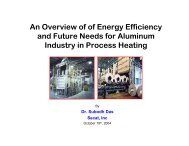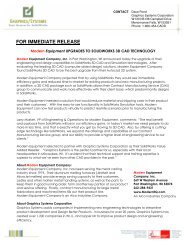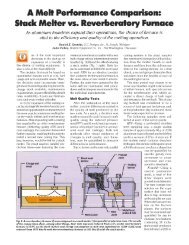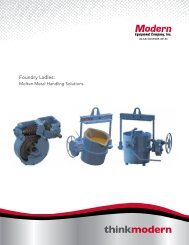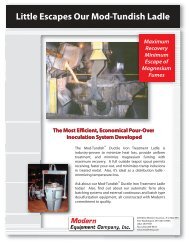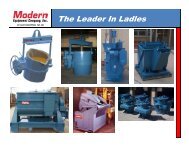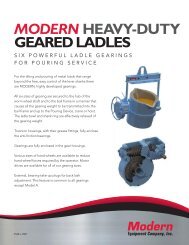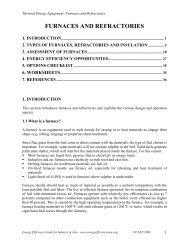ITP Metal Casting: Advanced Melting Technologies: Energy Saving ...
ITP Metal Casting: Advanced Melting Technologies: Energy Saving ...
ITP Metal Casting: Advanced Melting Technologies: Energy Saving ...
Create successful ePaper yourself
Turn your PDF publications into a flip-book with our unique Google optimized e-Paper software.
energy efficiency within the melt room. This tool would also allow metal casting companies to<br />
identify retrofit technologies that will have the largest impact on their bottom line.<br />
Optimized Use of Natural Gas, Carbon, and Oxygen<br />
The wrought steel producers use significantly more natural gas, carbon, and oxygen during<br />
melting than the metal casting industry. Combustion of natural gas, charge carbon, and CO to<br />
CO2 (post-combustion) can reduce electrical energy consumption by 150 kWh per ton of steel.<br />
The combustion of natural gas and carbon must be at least 40%<br />
efficient in order to reduce the<br />
total energy consumption. The use of post-combustion energy can be looked upon as virtually<br />
“free energy.”<br />
Research should be conducted to develop a computational fluid dynamics model of post<br />
combustion to better understand how to use the CO and CO2. Modeling and optimization of<br />
carbon oxidation is also an important research focus area. Models for the process can be<br />
developed that will<br />
use specific input parameters from plant operations.<br />
Flexible Heat Size and Scheduling<br />
Varying heat sizes and scheduling of heats are major sources of energy inefficiencies in the<br />
metal casting industry. If a new furnace was developed that would allow for flexibilities in<br />
production scheduling without the associated energy losses, significant cost<br />
and energy savings<br />
could be achieved. The principal batch melters<br />
today – induction furnaces, electric arc furnaces,<br />
reverberatories, and crucible furnaces – are all inefficient when used with flexible scheduling.<br />
New furnace designs must be developed with flexible-sized melting units and reduced heat<br />
requirements for the first heat. Research should also investigate low-conductivity refractory<br />
linings and other options for flexible melting units, such as single electrode DC, which has the<br />
potential to improve both productivity and energy efficiency.<br />
<strong>Metal</strong>-<strong>Casting</strong>-Sized Ladle <strong>Metal</strong>lurgy Furnaces<br />
One of the most effective systems in the wrought industry is the ladle metallurgy furnace where<br />
the temperature of the melt can be adjusted, chemistry of the melt optimized, and quality of the<br />
steel enhanced through treatment. It has been difficult to directly<br />
transfer this technology to the<br />
metal casting industry because of the small ladles used in<br />
the latter. Large heat losses from the<br />
smaller ladles limit the treatment time available without reheating the equipment, reducing the<br />
scope for alloy and flux dissolution.<br />
A potential research field to overcome these issues is to develop a metal casting-sized ladle<br />
metallurgy facility that is flexible in tonnage, allowing for adjustable tonnage within a single<br />
vessel. The system would be designed to minimize heat losses during operation and to allow<br />
reheating. This would offer the advantages<br />
of wrought types of ladle metallurgy facilities, such<br />
as<br />
enabling large amounts of alloy additions in ladle. This could help the metal casting industry<br />
reduce costs and increase the quality to levels similar in the wrought industry. It would allow<br />
metal casters to use primary furnaces as melters and use the ladle to do metallurgical refining and<br />
alloying.<br />
37



